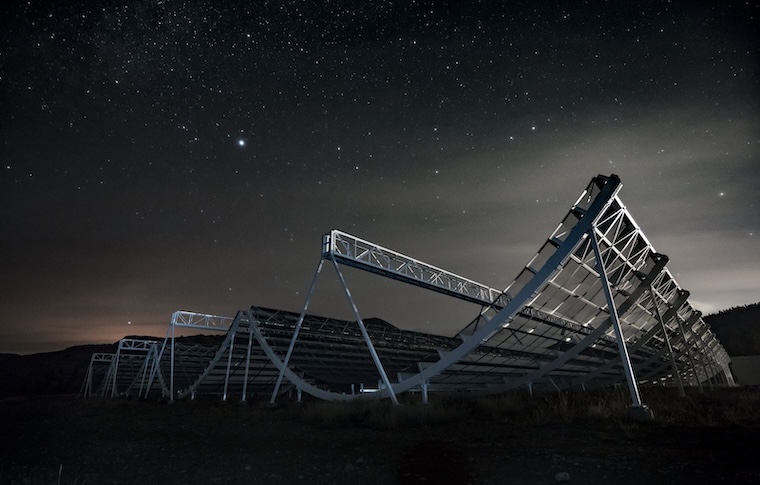Campus News
Researchers link mysterious cosmic signals to collapsed stars
An international team of scientists has provided the clearest evidence yet that some fast radio bursts (FRBs)—enigmatic, millisecond-long flashes of radio waves from space—originate from neutron stars, the ultra-dense remnants of massive stars that have exploded in a supernova.


An international team of scientists led by McGill University researchers has provided the clearest evidence yet that some fast radio bursts (FRBs)—enigmatic, millisecond-long flashes of radio waves from space—originate from neutron stars, the ultra-dense remnants of massive stars that have exploded in a supernova.
This finding, based on an analysis of the radio signal of a single FRB, advances our understanding of one of the universe’s most perplexing phenomena and was reported in two related studies published on January 2 in the journal Nature. The studies drew on data collected by the Canadian Hydrogen Intensity Mapping Experiment (CHIME) radio telescope.
FRB signals are often highly polarized, meaning that the radio waves predominantly oscillate along a specific, well-defined direction. This polarization is what first sparked Science Division Dean Bryan Gaensler’s interest in FRBs a decade ago, when he was at the University of Toronto. “Polarization is a vital extra clue that helps us understand what celestial objects are and why they shine,” he said. “I’m always keen to use polarization to find out things we can’t learn in any other way.”
Gaensler’s research interests focus on cosmic magnetism, time-domain astrophysics and interstellar gas, and currently, CHIME is his main research collaboration. For both studies, he helped develop the data pipeline and software needed to make the novel measurements, and then collaborated on the interpretation.
An incredible fact about FRBs is that they can release as much energy in milliseconds as the sun emits in an entire day. Scientists have detected thousands of these bursts since their discovery in 2007, yet their origins and mechanisms remain elusive. This first study identified a striking similarity between the behavior of the FRB signal and that of pulsars, a well-studied class of radio-emitting neutron stars.
“This result reaffirms long-held suspicions about the connection between FRBs and neutron stars,” said Ryan Mckinven, a doctoral researcher at McGill and the corresponding author of the first study. “However, our findings also challenge popular theoretical models, providing evidence that the radio emission occurs significantly closer to the neutron star than previously thought.”
By examining the polarization of the FRB signal, Mckinven’s team observed dramatic changes in its angle over the burst’s 2.5-millisecond duration, a characteristic typical of pulsars but rare in FRBs. This distinctive feature initially raised the possibility that the signal might be from a misclassified pulsar within the Milky Way. However, further analysis confirmed the FRB originated in a galaxy millions of light-years away.
“When we started looking at fast radio bursts with the CHIME telescope, I considered it critical that we made sure we could study polarization,” said Gaensler, a professor of astronomy and astrophysics at UC Santa Cruz, and author of a popular astronomy book titled Extreme Cosmos. “This capability has now been wonderfully showcased through the discovery of neutron-star-like polarization properties in FRBs.”
The research highlights the value of the CHIME telescope, located in Penticton, B.C. It is renowned for its unmatched ability to detect thousands of FRBs daily. The sheer volume of data from CHIME allows scientists to identify unique signals like this one, advancing the broader understanding of FRBs.
“This is a step closer to unravelling a profound cosmic mystery,” Mckinven said. “FRBs are ubiquitous, yet their true nature remains largely unknown. Every discovery we make about their origins opens a new window into the dynamics of the universe.”
In a second study of the same FRB published in Nature on January 2, lead researcher Kenzie Nimmo of the Massachusetts Institute of Technology provided additional support for the neutron-star conjecture. Nimmo said his team discovered that this FRB exhibits “twinkling,” similar to how stars appear to twinkle in the night sky.
“Observing this scintillation indicates that the region where the FRB originated must be incredibly small. We have pinpointed the emission site to a size of less than 10,000 kilometres, despite the FRB originating over 200 million light-years away,” Nimmo said. “This extraordinary precision reveals that the FRB must have come from the intensely magnetic environment surrounding a neutron star, one of the most extreme environments in the universe.”
Together, the Mckinven- and Nimmo-led studies make a strong new case that this FRB—and by extension, others—have their origins in a neutron star.
For more on the fascination with fast radio bursts, read the Q & A with Gaensler and fellow UC Santa Cruz astrophysicist J. Xavier Prochaska.